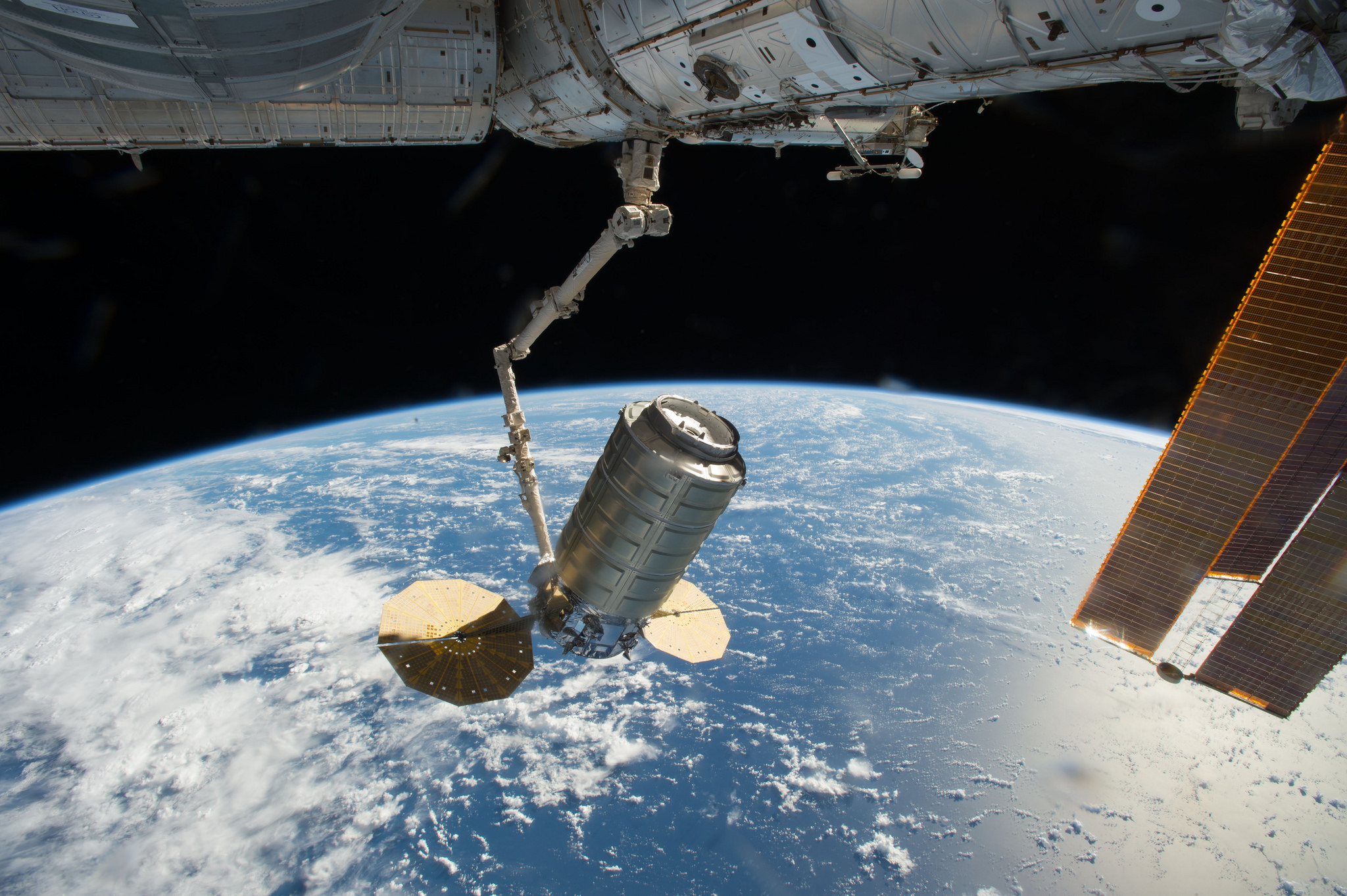Orbital ATK's next Cygnus cargo delivery mission to the International Space Station for NASA will lift off on March 16, NASA officials said Tuesday (Jan. 10).
A United Launch Alliance Atlas V rocket will launch the unmanned Cygnus spacecraft's OA-7 resupply mission from Cape Canaveral Air Force Station in Florida.
"Orbital ATK will launch Cygnus atop a United Launch Alliance (ULA) Atlas V rocket for delivery of essential crew supplies, equipment and scientific experiments to astronauts aboard the International Space Station," NASA officials wrote in a statement. "The 30 minute launch window opens at 12:29 a.m. EDT."
In November, Orbital ATK announced that this upcoming Cygnus cargo mission would launch on a ULA Atlas V rocket — and not Orbital ATK's own Antares rocket — in order to maximize the amount of supplies delivered to the International Space Station, as well as maintain the company's launch schedule. Future Cygnus flights will launch on Orbital ATK's Antares rockets from the company's launch site on Wallops Island, Virginia.
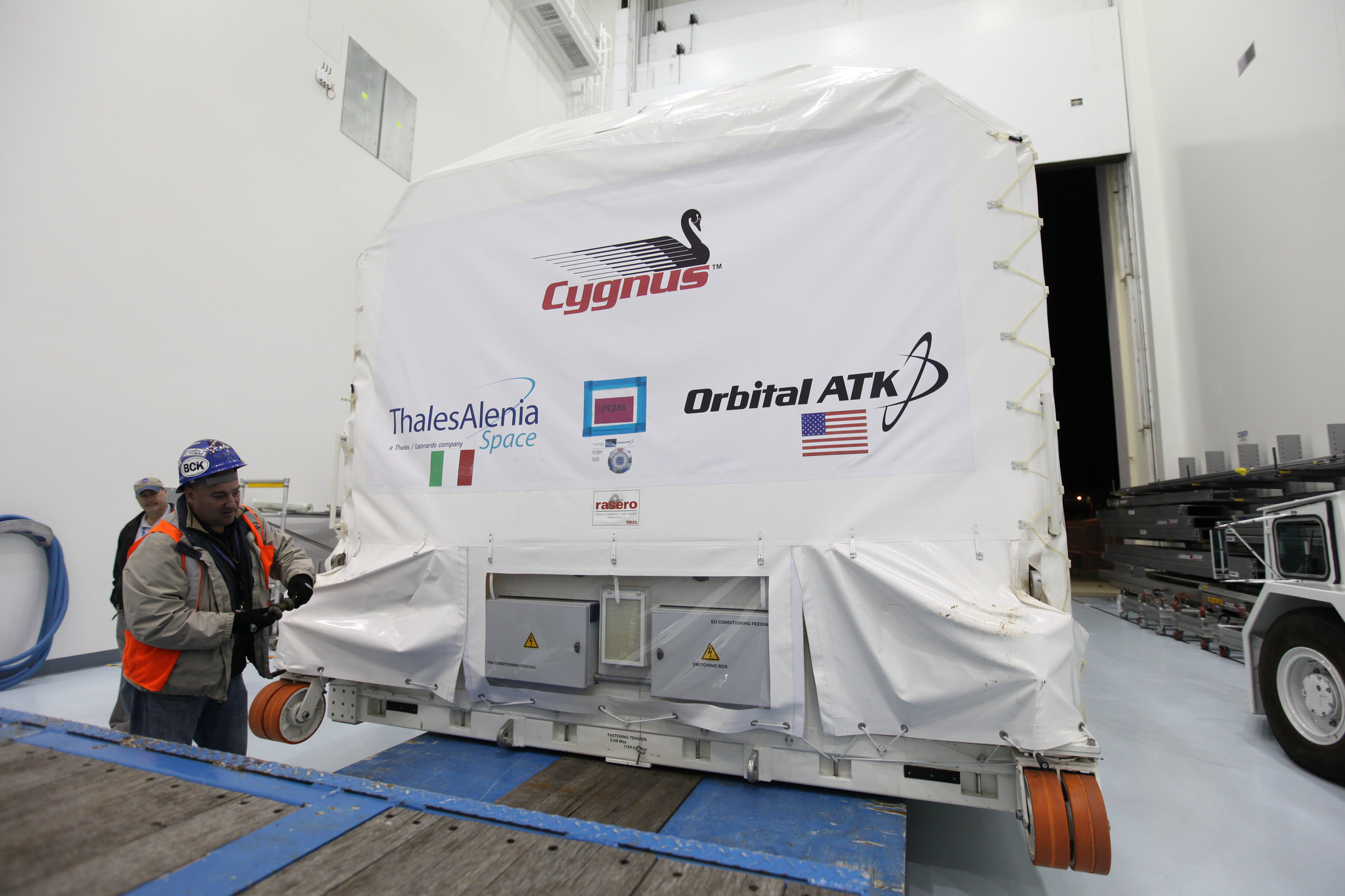
Orbital ATK successfly returned its Antares rocket to flight on Oct. 17, nearly two years after a failed Cygnus launch in Oct. 2014. Between that Antares launch failure and the booster's return to flight, the company launched two Cygnus missions on Atlas V rockets, one December 2015 and the other in March 2016.
Orbital ATK is one of two private companies (SpaceX is the other) currently flying cargo resupply missions for NASA. OA-7 is the seventh of 10 delivery missions for NASA that Orbital ATK is scheduled to launch under its current contract.
Quelle: SC
---
Next Cygnus Mission to Station Set for March


Orbital ATK has completed a significant mission milestone for NASA’s next International Space Station cargo mission.
The Pressurized Cargo Module (PCM) of the Cygnus spacecraft has arrived at NASA’s Kennedy Space Center for processing and assembly before launch. The OA-7 mission is targeted to launch on Thursday, March 16 from Space Launch Complex 41 at Cape Canaveral Air Force Station in Florida.
Orbital ATK will launch Cygnus atop a United Launch Alliance (ULA) Atlas V rocket for delivery of essential crew supplies, equipment and scientific experiments to astronauts aboard the International Space Station. The 30 minute launch window opens at 12:29am EDT.
OA-7 will mark Orbital ATK’s seventh cargo delivery mission for NASA under its Commercial Resupply Services (CRS) -1 contract.
Quelle: NASA
-
Update: 4.02.2017
.
NASA has opened media accreditation for the next Orbital ATK launch of a commercial resupply mission to the International Space Station. The Cygnus spacecraft is targeted to launch March 19, during a 30-minute window that opens at approximately 10:56 p.m. EDT.
Cygnus will launch on a United Launch Alliance Atlas V rocket from Space Launch Complex 41 at Cape Canaveral Air Force Station (CCAFS) in Florida. The spacecraft will carry crew supplies and vehicle hardware to the orbital laboratory to support the Expedition 50 and 51 crews.
Media prelaunch and launch activities will take place at CCAFS and NASA’s nearby Kennedy Space Center.
- International media without U.S. citizenship must apply by 4:30 p.m. on Wednesday, Feb. 15, for access to Cape Canaveral and Kennedy.
- International media without U.S. citizenship must apply by 4:30 p.m. on Monday, March 6, for access to Kennedy.
- U.S. media must apply by 4:30 p.m. Thursday, March 9.
All media accreditation requests should be submitted online.
International media are required to upload a scanned copy of their media visa and passport or green card with their accreditation requests. Media must present two forms of unexpired, government identification to enter Kennedy. One form must include a photo, such as a passport or driver’s license.
Questions about accreditation may be addressed to Jennifer Horner at jennifer.p.horner@nasa.gov or 321-867-6598. For other questions, or additional information, contact Kennedy’s newsroom at 321-867-2468.
Investigations scheduled on this launch include an Advanced Plant Habitat, which will integrate new technology to increase overall efficiency, reliability, and robustness of plants grown on station. This experiment will build on the success of NASA’s Veggie, the first fresh food growth system on station, and will provide ongoing research for the development of food production systems for long-duration exploration missions.
Manipulating cell cultures in space is challenging as the cells can spontaneously grow in 3-D. Another new investigation bound for the U.S. National Laboratory will look at using magnetized cells and tools to make it easier to handle cells and cultures, and improve the reproducibility of experiments.
The Slosh Coating experiment will investigate a special type of coating that can repel liquids when applied to container walls. If effective, the liquid repellent could be used to design more efficient storage tanks for propellant and other fluids used in space exploration.
There also will be a number of CubeSats onboard Cygnus that will be deployed from the NanoRacks CubeSat Deployment on the space station, including a NASA science payload known as IceCube, which will provide data to scientists’ understanding of ice clouds and their role in climate change.
The International Space Station is a convergence of science, technology and human innovation that demonstrates new technologies and makes research breakthroughs not possible on Earth. The space station has been occupied continuously since November 2000. In that time, more than 200 people and a variety of international and commercial spacecraft have visited the orbiting laboratory. The space station remains the springboard to NASA's next great leap in exploration, including future missions to an asteroid and Mars.

Quelle: NASA
-
Update: 5.02.2017
.
ULA’s navy delivers rocket that will launch supplies to the space station
PORT CANAVERAL — The ocean-sailing ship that transports rocket stages from United Launch Alliance’s factory to U.S. launch sites completed its latest voyage overnight, pulling into port to deliver the Atlas 5 that will send a cargo freighter to the International Space Station in March.
The Mariner, owned and operated by the Foss Maritime company, made a week-long voyage from the ULA production facility in Decatur, Alabama to Cape Canaveral, Florida.
Originally built to carry Delta 4 rockets for Boeing to the Cape and Vandenberg Air Force Base, California, the Mariner now also delivers Atlas 5 stages for ULA whenever circumstances permit.
The Atlas 5’s original mode of transportation — the massive Antonov aircraft — continues to be used sparingly.
The custom-made, purpose-built cargo ship entered service in 2000. The 312-foot-long roll-on/roll-off vessel has a crew of 16, carries over 100,000 gallons of fuel and is powered by engines derived from a locomotive.
It features full living quarters, a kitchen and dining area, a fabrication shop below deck and even a helipad.
Construction of the Atlas was performed inside the sprawling Decatur factory, followed by full testing and being readied for transport to Florida.
The Mariner traversed 270 miles up the Tennessee River, 60 miles on the Ohio River and 646 miles down the Mississippi River. The trek then covered 815 miles through the Gulf of Mexico and around to Florida’s east-central coast to Port Canaveral.
A trip’s round-the-clock average speed is about 12 mph.
Now at the harbor in Port Canaveral, a semi-trucks will drive the 106.6-foot-long, 12.5-foot-diameter bronze-colored booster stage and 41.5-foot-long, 10-foot-diameter Centaur upper stage off the Mariner and up through Cape Canaveral Air Force Station on Monday.
The first stage goes to the Atlas Spaceflight Operations Center high bay for receiving checks and the Centaur will be processed at the Delta Operations Center and integrated with the interstage and boattail.
Later, the stages will be taken further up the road to the Vertical Integration Facility at Complex 41 for stacking aboard the mobile launch platform.
Once the first stage is erected, the interstage and Centaur will be hoisted and attached to complete the basic build up of the Atlas 5 rocket, designated AV-070.
Installation of the encapsulated payload will occur about one week before launch to top off the 194-foot-tall rocket.

The mission, slated for March 19 at 10:56 p.m. EDT (0256 GMT), will launch the Orbital ATK OA-7 Cygnus spacecraft filled with 7,700 pounds of provisions and experiments for the International Space Station.
The Atlas 5 rocket’s yaw-steering ability will enable a 30-minute launch window — extending 15 minutes before and after the instant when the station’s orbital plane passes over the pad.
It will be Orbital ATK’s seventh resupply mission to the station under NASA’s commercial cargo-delivery program.
The pressurized cargo module for Cygnus arrived at Kennedy Space Center’s Space Station Processing Facility on Jan. 9. The craft’s propulsion section arrived Feb. 1.
The two pieces will be mated together and initial cargo loading performed at the SSPF before the Cygnus is moved to the nearby Payload Hazardous Servicing Facility for propellant loading and the stowage of late-load cargo items.
Encapsulation of the ship in the Atlas 5 rocket’s 14-foot-wide, 45-foot-long extra extended payload fairing (XEPF) will occur at the SSPF, too.
Previous Cygnus spacecraft have been given a ceremonial name for a former astronaut who has since passed away. The name for OA-7 has not yet been revealed.

NASA requested that this Cygnus be launched aboard the Atlas 5 instead of Orbital ATK’s revamped Antares rocket. The switch allows the craft to carry a greater amount of supplies and gives the space agency better schedule assurance.
The Atlas 5 successfully launched two Cygnus missions — in December 2015 and March 2016 — while the Antares fleet was grounded to upgrade its engines from stockpiled Soviet-era powerplants to modern-day Russian ones.
** CYGNUS FLIGHT HISTORY **
Demo — Antares — 1,299 pounds — Launched Sept. 18, 2013
Orb 1 — Antares — 2,780 pounds — Launched Jan. 9, 2014
Orb 2 — Antares — 3,293 pounds — Launched July 13, 2014
Orb 3 — Antares — 4,883 pounds — Launched Oct. 28, 2014 *Failure
OA-4 — Atlas 5 — 7,746 pounds — Launched Dec. 6, 2015
OA-6 — Atlas 5 — 7,758 pounds — Launched March 22, 2016
OA-5 — Antares — 5,163 pounds — Launched Oct. 17, 2016
Among the science projects being launched in this upcoming OA-7 Cygnus include an Advanced Plant Habitat as a stepping-stone to food production systems on long-duration exploration missions, new tests on cell cultures in space for biological research, a technology experiment into coatings applied to container walls that could benefit fuel storage tanks, a host of cubesats that will be launched from the station, the third spacecraft fire test to study flames in microgravity and another try at collecting data during atmospheric reentry at the mission’s conclusion.
Quelle: SN
-
Update: 6.03.2017
.
In the Space Station Processing Facility high bay at NASA's Kennedy Space Center in Florida, the Orbital ATK CYGNUS pressurized cargo module is secured the KAMAG transporter and the crane has been removed. Technicians secure the protective covering around CYGNUS. The module will be transported to the Payload Hazardous Servicing Facility. The Orbital ATK CRS-7 commercial resupply services mission to the International Space Station is scheduled to launch atop a United Launch Alliance Atlas V rocket from Space Launch Complex 41 at Cape Canaveral Air Force Station on March 19, 2017. CYGNUS will deliver thousands of pounds of supplies, equipment and scientific research materials to the space station.
Quelle: NASA
---
Update: 8.03.2017
.

Quelle: ATK
Orbital ATK has completed a significant mission milestone for NASA’s next International Space Station cargo mission.
The Pressurized Cargo Module (PCM) of the Cygnus spacecraft has arrived at NASA’s Kennedy Space Center for processing and assembly before launch. The OA-7 mission is targeted to launch on Thursday, March 16 from Space Launch Complex 41 at Cape Canaveral Air Force Station in Florida.
Orbital ATK will launch Cygnus atop a United Launch Alliance (ULA) Atlas V rocket for delivery of essential crew supplies, equipment and scientific experiments to astronauts aboard the International Space Station. The 30 minute launch window opens at 12:29am EDT.
OA-7 will mark Orbital ATK’s seventh cargo delivery mission for NASA under its Commercial Resupply Services (CRS) -1 contract.
---
Update: 9.03.2017
Atlas V to Launch OA-7 for Orbital ATK and NASA

Date/Site/Launch Time:Sunday, March 19, 2017, from Space Launch Complex (SLC)-41 at Cape Canaveral Air Force Station, Florida. The 30-minute launch window opens at 10:56 p.m. EDT.
Live Broadcast: Look for more information about how you can tune in LIVE!
Mission Description: Orbital ATK developed the Cygnus advanced maneuvering spacecraft to perform ISS cargo delivery missions under the Commercial Resupply Service (CRS) contract with NASA. At a total weight of approximately 7,225 kg (15,928 lb), OA-7 will include approximately 3,380 kg (7,452 lb) of internal cargo and an 83 kg (183 lb) external deployer carrying CubeSats.
Launch Notes: This mission marks the third time ULA’s Atlas V has launched Orbital ATK’s Cygnus™ spacecraft on its way to the ISS. OA-7 will be the 71st launch of the Atlas V rocket since its first launch in 2002. The Atlas V 401 configuration rocket has flown 35 times, supporting a diverse set of missions, including national security, science and exploration, commercial as well as International Space Station resupply.
Next Cygnus commercial space freighter christened the S.S. John Glenn
CAPE CANAVERAL — Orbital ATK’s next commercial resupply freighter going to the International Space Station will be named the S.S. John Glenn, paying tribute to the legendary first American to orbit the Earth.
Glenn died Dec. 8 at age 95.
The company has made it tradition to give each of its autonomous Cygnus cargo ships launched under NASA’s privatized logistics delivery program to the space station a name to honor a former astronaut who has passed away.
Previous Cygnus vehicles have been named for G. David Low, C. Gordon Fullerton, Janice Voss, Deke Slayton, Rick Husband and Alan Poindexter.
John H. Glenn Jr., a decorated combat veteran and test pilot, was one of the original Mercury 7 — the pioneering cadre of NASA astronauts at the dawn of the space age.
He rocketed into human history on Feb. 20, 1962, strapped in the Friendship 7 capsule atop an Atlas rocket, to become the first American to orbit the planet.
While lasting only five hours before splashing down near Bermuda, the trail-blazing flight achieved a critical step in the pursuit to live and work in space.
After serving for a quarter-century as a senator from his beloved home state of Ohio, Glenn left the U.S. Congress and returned to NASA to train as a payload specialist and serve as the oldest human subject in biological tests conducted in the microgravity environment of space.
His triumphant return to space, at age 77, came aboard shuttle Discovery’s STS-95 mission in 1998, spending 9 days being poked and prodded in the name of medical research.

Glenn always remained a steadfast advocate for space and the promise that experiments aboard the International Space Station could lead to breakthroughs to improve life on Earth.
The S.S. John Glenn, launching atop an Atlas 5 rocket, will carry about 7,500 pounds of crew provisions and fresh science investigations to the space station this month.
Experiments include studies with lung cancer cells, chemotherapy drugs, improving radiological detectors for homeland security, a plant-growing chamber for harvesting food in space and a technology demonstration for science sample return capsules.
Cygnus has been fully loaded and its hatch sealed for flight at Kennedy Space Center’s Payload Hazardous Servicing Facility. It will be encapsulated within the launch vehicle’s nose cone tomorrow.
United Launch Alliance is responsible for getting John Glenn back into space, using the Atlas 5 to propel the 16,000-pound ship into low-Earth orbit from Cape Canaveral on March 19.
The 30-minute launch window opens at 10:56 p.m. EDT (0256 GMT).
Cygnus will be moved to the Atlas 5 rocket’s vertical assembly building on Monday for attachment to the launcher.
The mission is otherwise known in the space station scheduling matrix as OA-7.

After an automated rendezvous with the station, the Cygnus will pause its approach within reach of the Canadarm2 robotic arm. The arm will grab a capture device on the ship’s exterior around 6:05 a.m. on March 23 and maneuver it to a berthing port on the underside of the Unity module for attachment and unloading.
It is scheduled to spend about three months attached to the station, allowing the resident astronauts to empty the cargo and fill the vessel with trash and disposables.
After departing the station, Cygnus will climb to a higher altitude to deploy cubesats and conduct another in a series of contained fire experiments to better understand how flames behave in microgravity.
The S.S. John Glenn concludes its mission this summer in a blaze of glory, re-entering harmlessly over the South Pacific.
Quelle: SN
---
Update: 11.03.2017
.
Rocket Issue Delays Orbital ATK's Next Cargo Launch for NASA
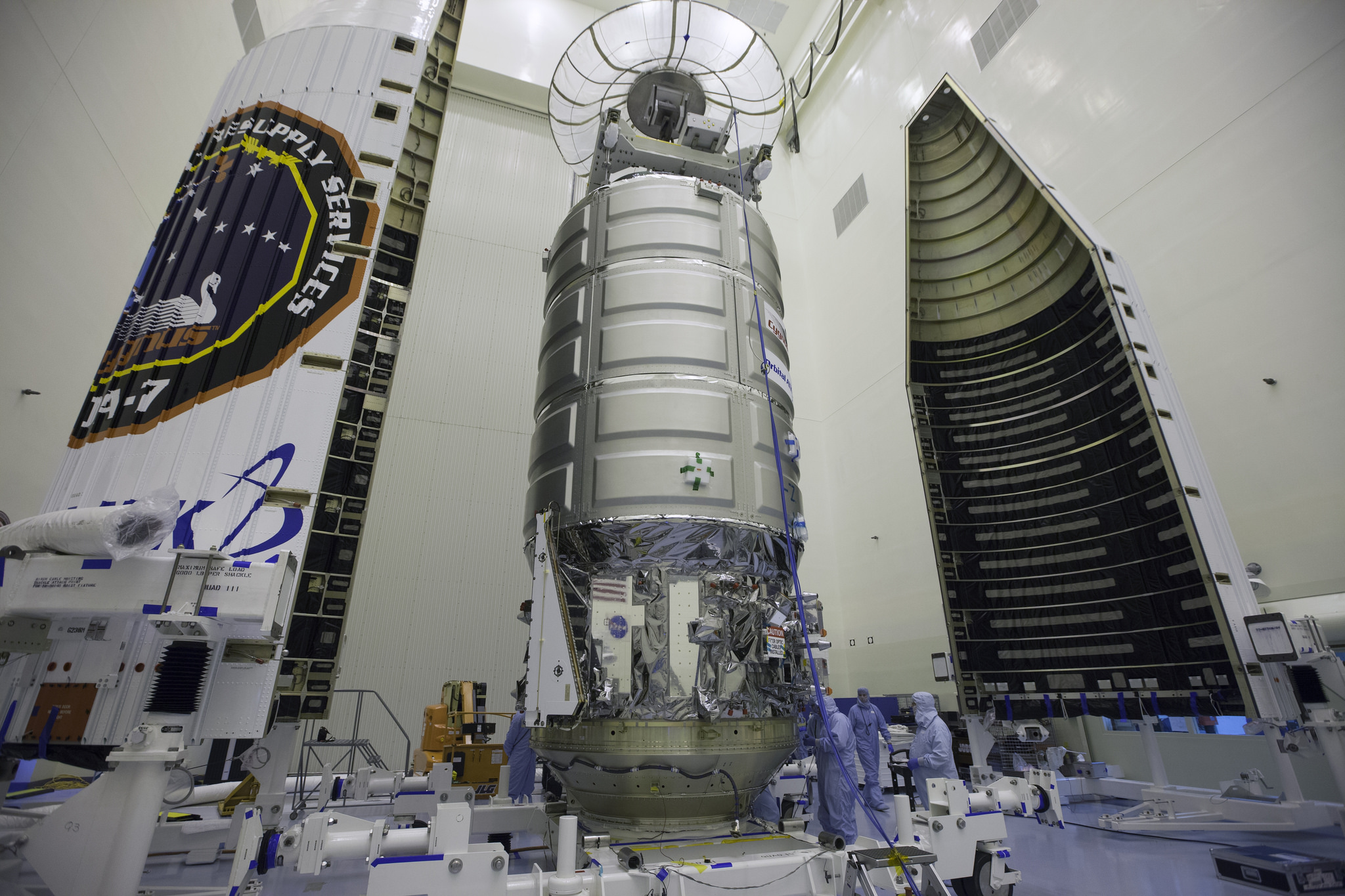
The launch of an Orbital ATK cargo ship to deliver nearly 4 tons of NASA to the International Space Station this month has been delayed by at least two days due to a rocket glitch.
The robotic Cygnus cargo ship, which was previously scheduled to launch March 19 from a pad at Florida's Cape Canaveral Air Force Station, will now lift off no earlier than March 21 at 10:56 p.m. EDT (0256 GMT), according to a NASA statement released Friday (March 10). The space agency cited a technical issue with the United Launch Alliance (ULA) Atlas V rocket that will launch the Cygnus as the delay's cause.
"During prelaunch testing March 10, ULA discovered a booster hydraulic issue at the pad, and the additional time will allow their team to replace a component and continue with launch preparations," NASA officials wrote in a statement.
Orbital ATK's Cygnus spacecraft is packed with 7,600 lbs. (3,447 kilograms) of supplies and research equipment for the space station's crew.
The OA-7 mission will be the seventh delivery mission for NASA by Orbital ATK, and the third to launch a Cygnus spacecraft using an Atlas V rocket. Orbital ATK typically uses its own Antares rockets for Cygnus flights. The company launched two missions on Atlas V boosters while recovering from an Antares failure in 2014 and opted to use an Atlas V for the OA-7 due to the booster's ability to launch more cargo.
Orbital ATK's Cygnus will be the second commercial cargo ship to haul supplies to the International Space Station for NASA this year. On Feb. 23, a SpaceX Dragon spacecraft arrived at the station to deliver 5,500 lbs. (2,500 kilograms) of supplies.
The Cygnus spacecraft that will fly on the OA-7 mission has been named the S.S. John Glenn by Orbital ATK to honor astronaut John Glenn, the first American to orbit Earth, who died in December.
Quelle: SC
---
Update: 12.03.2017
.
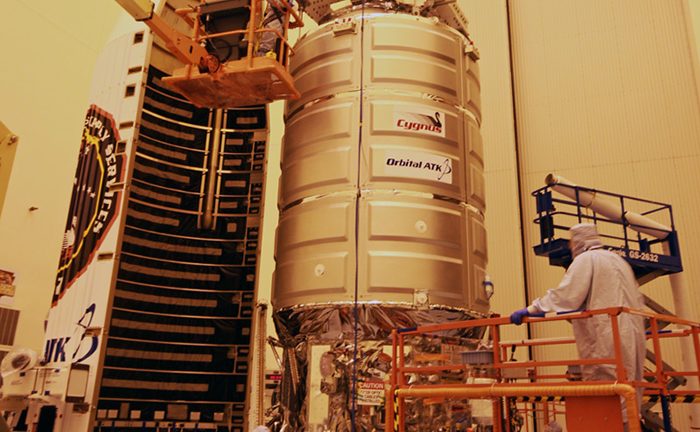
NEXT CYGNUS CARGO SHIP CHRISTENED THE SS JOHN GLENN TO HONOR FIRST AMERICAN IN ORBIT
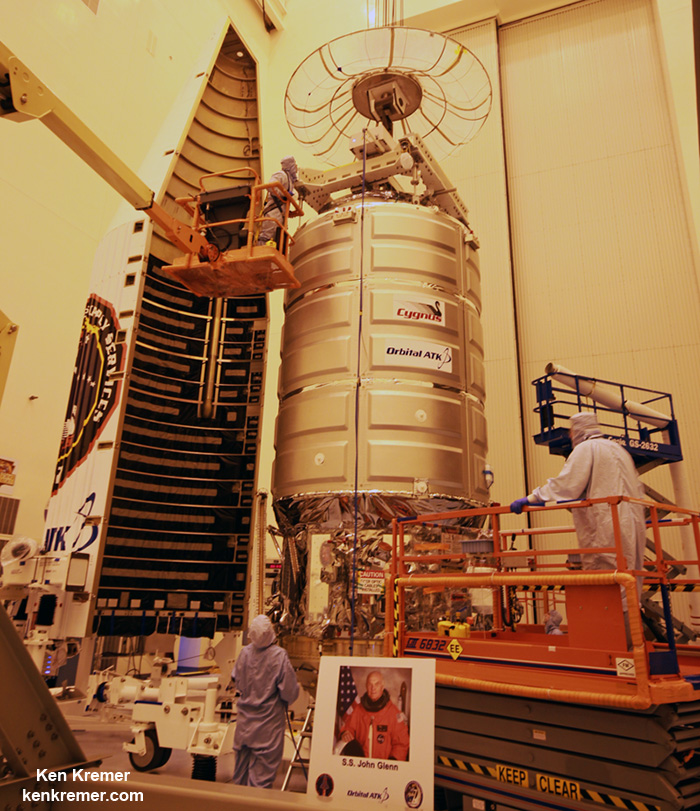
The Orbital ATK Cygnus spacecraft named for Sen. John Glenn, one of NASA’s original seven astronauts, stands inside the Payload Hazardous Servicing Facility at NASA’s Kennedy Space Center in Florida behind a sign commemorating Glenn on March 9, 2017. Launch slated for March 21 on a ULA Atlas V. Credit: Ken Kremer/Kenkremer.com
KENNEDY SPACE CENTER, FL – The next Cygnus cargo ship launching to the International Space Station (ISS) has been christened the ‘S.S. John Glenn’ to honor legendary NASA astronaut John Glenn – the first American to orbit the Earth back in February 1962.
John Glenn was selected as one of NASA’s original seven Mercury astronauts chosen at the dawn of the space age in 1959. He recently passed away on December 8, 2016 at age 95.
The naming announcement was made by spacecraft builder Orbital ATK during a ceremony with the ‘S.S. John Glenn’, held inside the Kennedy Space Center (KSC) clean room facility where the cargo freighter is in the final stages of flight processing – and attended by media including Universe Today on Thursday, March 9.
“It is my humble duty and our great honor to name this spacecraft the S.S. John Glenn,” said Frank DeMauro, vice president and general manager of Orbital ATK’s Advanced Programs division, during the clean room ceremony in the inside the Payload Hazardous Servicing Facility high bay at NASA’s Kennedy Space Center in Florida.

The next Orbital ATK Cygnus supply ship was christened the SS John Glenn in honor of Sen. John Glenn, one of NASA’s original seven astronauts as it stands inside the Payload Hazardous Servicing Facility at NASA’s Kennedy Space Center on March 9, 2017. Launch slated for March 21 on a ULA Atlas V. Credit: Ken Kremer/Kenkremer.com
The S.S. John Glenn is scheduled to liftoff as the Orbital ATK Cygnus OA-7 spacecraft for NASA on a United Launch Alliance (ULA) Atlas V rocket launch no earlier than March 21 from Space launch Complex-41 (SLC-41) on Cape Canaveral Air Force Station, Florida.
The space station resupply mission dubbed Cygnus OA-7 is dedicated to Glenn and his landmark achievement as the first American to orbit the Earth on Feb. 20, 1962 and his life promoting science, human spaceflight and education.
“John Glenn was probably responsible for more students studying math and science and being interested in space than anyone,” said former astronaut Brian Duffy, Orbital ATK’s vice president of Exploration Systems, during the clean room ceremony on March 9.
“When he flew into space in 1962, there was not a child then who didn’t know his name. He’s the one that opened up space for all of us.”

The Orbital ATK Cygnus OA-7 supply ship named in honor of Sen. John Glenn, one of NASA’s original seven astronauts stands inside the Payload Hazardous Servicing Facility at KSC. Launch slated for March 21 on a ULA Atlas V. Credit: Julian Leek
Glenn’s 3 orbit mission played a pivotal role in the space race with the Soviet Union at the height of the Cold War era.
“He has paved the way for so many people to follow in his footsteps,” said DeMauro.
All of Orbital ATK’s Cygnus freighters have been named after deceased American astronauts.
Glenn is probably America’s most famous astronaut in addition to Neil Armstrong, the first man to walk on the moon during Apollo 11 in 1969.
John Glenn went on to become a distinguished U.S. Senator from his home state of Ohio on 1974. He served for 24 years during 4 terms.
He later flew a second mission to space aboard the Space Shuttle Discovery in 1998 as part of the STS-95 crew at age 77. Glenn remains the oldest person ever to fly in space.
“Glenn paved the way for America’s space program, from moon missions, to the space shuttle and the International Space Station. His commitment to America’s human space flight program and his distinguished military and political career make him an ideal honoree for the OA-7 mission,” Orbital ATK said in a statement.
“The OA-7 mission is using the Enhanced Cygnus Pressurized Cargo Module (PCM) to deliver cargo to the International Space Station,” said DeMauro.
Cygnus will carry 7,700 pounds (3500 kg) of cargo to the station with a total volumetric capacity of 27 cubic meters.
“All these teams have worked extremely hard to get this mission to this point and we are looking forward to a great launch.”
This is the third Cygnus to launch on an Atlas V rocket from the Cape. The last one launched a year ago on March 24, 2016 during the OA-6 mission. The first one launched in December 2015 during the OA-4 mission.
“We’re building the bridge to history with these missions,” said Vernon Thorp, ULA’s program manager for Commercial Missions. “Every mission is fantastic and every mission is unique. At the end of the day every one of these missions is critical.”
The other Cygnus spacecraft have launched on the Orbital ATK commercial Antares rocket from NASA Wallops Flight Facility on Virginia’s eastern shore.
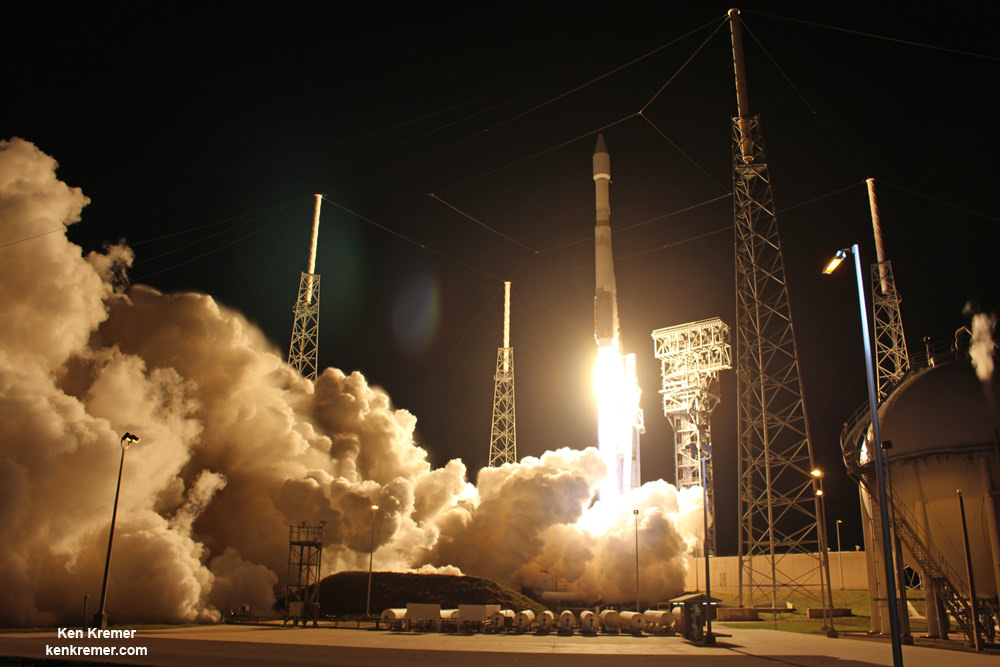
A United Launch Alliance (ULA) Atlas V rocket carrying the Orbital ATK Cygnus OA-6 mission lifted off from Space Launch Complex 41 at 11:05 p.m. EDT on March 22, 2016 from Cape Canaveral Air Force Station, Fla. Credit: Ken Kremer/kenkremer.com
Overall this is Orbital ATK’s seventh commercial resupply services mission (CRS) to the space station under contract to NASA.
OA-7 also counts as NASA’s second supply mission of the year to the station following last month’s launch of the SpaceX Dragon CRS-10 capsule on Feb. 19 and which is currently berthed to the station at a Earth facing port on the Harmony module.

Historic maiden blastoff of SpaceX Falcon 9 rocket from Launch Complex 39A at the Kennedy Space Center) at 9:38 a.m. EDT on Feb 19, 2017, on Dragon CRS-10 resupply mission to the International Space Station (ISS) for NASA. Credit: Ken Kremer/kenkremer.com
Stay tuned here for Ken’s continuing Earth and Planetary science and human spaceflight news.
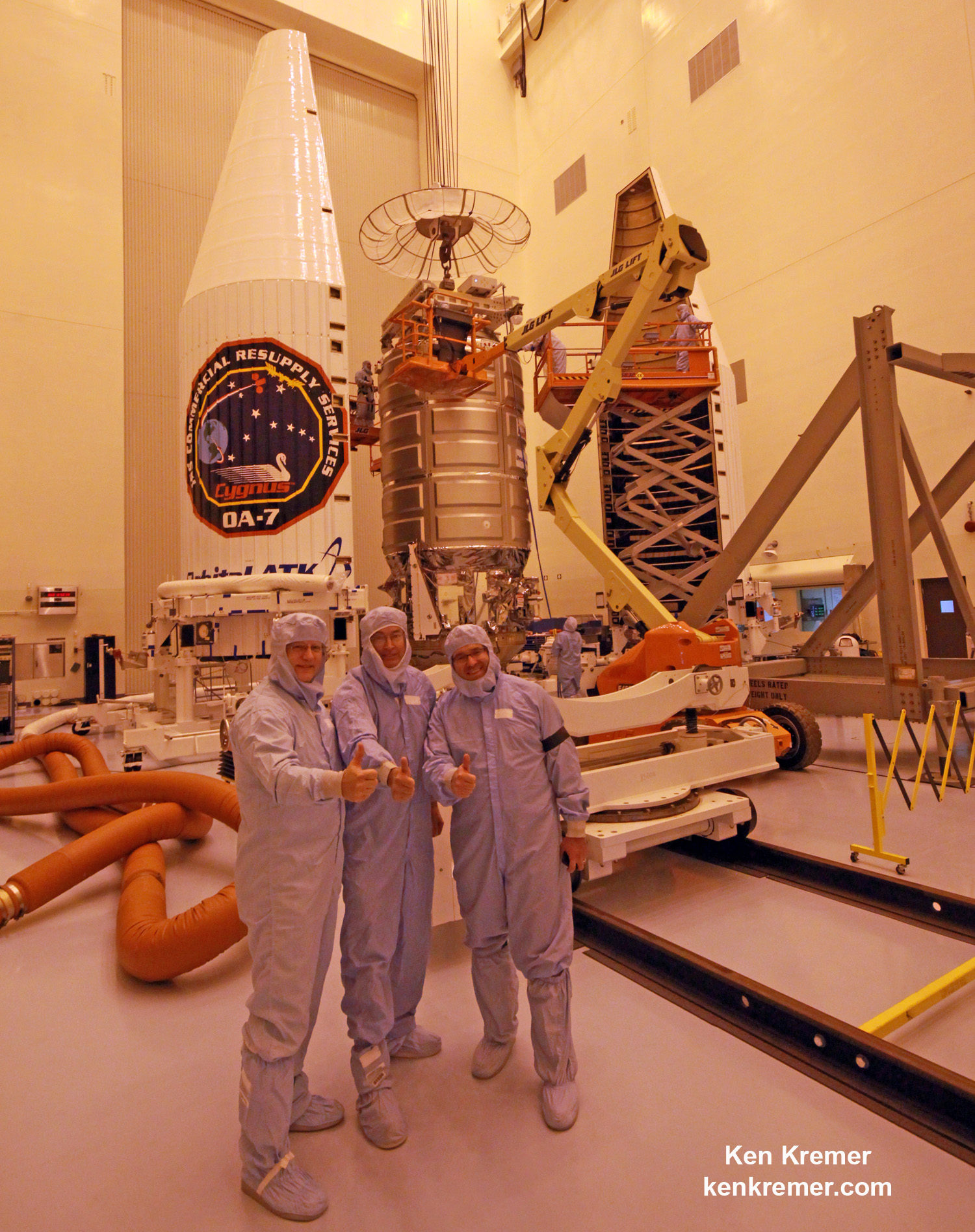
Posing with the newly christened SS John Glenn for the Cygnus OA-7 resupply mission to the ISS are Vern Thorp, United Launch Alliance Program program manager for Commercial Missions, Ken Kremer, Universe Today and Frank DeMauro, Orbital ATK vice president and general manager of Orbital ATK’s Advanced Programs division inside the Payload Hazardous Servicing Facility cleanroom at NASA’s Kennedy Space Center on March 9, 2017. Credit: Ken Kremer/Kenkremer.com
Quelle: UT
---
Update: 18.03.2017
.
S.S. John Glenn vessel mounted atop Atlas 5 rocket for launch next week

CAPE CANAVERAL — An eight-ton cargo ship destined for the International Space Station was hoisted aboard its United Launch Alliance Atlas-Centaur booster rocket today in preparation for liftoff to the orbiting laboratory next week.
The commercial Cygnus freighter — christened the S.S. John Glenn in tribute to America’s first man to orbit Earth — is scheduled for launch either Thursday, March 23 or Friday, March 24 from Complex 41 at Cape Canaveral. A final determination of the date is expected Monday, based on Range availability.
ULA is boosting its third Cygnus payload for Orbital ATK, allowing the vessel to carry its maximum amount of cargo to the station.
March 23: Launch window 9:23-9:53 p.m. EDT; Rendezvous March 27
March 24: Launch window 9:00-9:30 p.m. EDT; Rendezvous March 28
March 25: Launch window 8:37-9:07 p.m. EDT; Rendezvous March 29
Liftoff was delayed a few days to replace a component in the first stage hydraulics that showed suspect behavior in pre-flight testing. Further date uncertainty was created by two SpaceX postponements and the ripple effects that had with scheduling on the Eastern Range.
The Cygnus mission, known as OA-7 under NASA’s Commercial Resupply Service contract, carries 7,443 pounds of internal cargo and an 183-pound external deployer with cubesats.
The freighter weighs 15,928 pounds in totality.
“We have more than 2,000 pounds of scientific experiments on board spanning all fields of science onboard,” said Holly Vavrin, a commercial visiting vehicle engineer in NASA’s International Space Station Program Office.
“There are also 38 CubeSats launching on this mission, including four that will launch from the Cygnus and 34 that will be launched from the station to conduct a range of experiments including testing long-life battery systems, study cloud systems and measure background radiation.”

The craft departed from the Payload Hazardous Servicing Facility at 12:30 a.m. today, riding aboard its motorized transporter north through the Kennedy Space Center, past the Vehicle Assembly Building and pad 39A, then down the coastal road to the Atlas 5 rocket’s Vertical Integration Facility.
It arrived at 3:30 a.m. and hoisting operations began at 7:30 a.m.
The VIF is where the Atlas 5 has been assembled aboard its mobile launch platform. There, an overhead crane lifted the encapsulated Cygnus atop the Centaur upper stage to top off the 194-foot-tall rocket.
Rollout to the Complex 41 pad will occur two days before launch.
In keeping with its tradition of naming Cygnus vehicles for distinguished astronauts who have passed away, Orbital ATK selected John Glenn for this mission. He died in December at age 95.
“John Glenn was probably responsible for more students studying math and science and being interested in space than anyone,” said former astronaut Brian Duffy, Orbital ATK’s vice president of Exploration Systems.
“When he flew into space in 1962, there was not a child then who didn’t know his name. He’s the one that opened up space for all of us.”
Glenn was one of NASA’s original Mercury astronauts and flew the first American orbital spaceflight by a human in 1962. He returned to space aboard shuttle Discovery for a science mission in 1998.
“He has paved the way for so many people to follow in his footsteps,” said Frank DeMauro, vice president and general manager of Orbital ATK’s Advanced Programs division. “It is my humble duty and our great honor to name this spacecraft the S.S. John Glenn.”
Quelle: SN
---
Update: 12.04.2017
.
NASA commercial cargo provider Orbital ATK is targeting its seventh commercial resupply services mission to the International Space Station for 11:11 a.m. EDT Tuesday, April 18. Coverage of the launch begins at 10 a.m. on NASA Television and the agency’s website.
Two prelaunch briefings will air the day prior to launch. At 10:30 a.m., mission managers will provide an overview and status of launch operations and at 1 p.m., scientists and researchers will discuss some of the investigations to be delivered to the station.
Dubbed S.S. John Glenn, the Cygnus spacecraft name is a tribute to the former astronaut and U.S. Senator from Ohio. It will launch on a United Launch Alliance Atlas V rocket from Space Launch Complex 41 at Cape Canaveral Air Force Station in Florida. Coverage of the spacecraft’s solar array deployment will begin at 12:40 p.m. April 18, and will be followed by a 2 p.m. press conference with mission managers.
Under NASA’s Commercial Resupply Services contract, Cygnus will carry more than 7,600 pounds of science research, crew supplies and hardware to the orbiting laboratory in support of the Expedition 50 and 51 crew members.
The new experiments will include an antibody investigation that could increase the effectiveness of chemotherapy drugs for cancer treatment and an advanced plant habitat for studying plant physiology and growth of fresh food in space. Another new investigation bound for the U.S. National Laboratory will look at using magnetized cells and tools to make it easier to handle cells and cultures, and improve the reproducibility of experiments. Cygnus also is carrying 38 CubeSats, including many built by university students from around the world as part of the QB50 program. The CubeSats are scheduled to deploy from either the spacecraft or space station in the coming months.
When it arrives to the space station, Expedition 51 Commander Peggy Whitson of NASA and Flight Engineer Thomas Pesquet of ESA (European Space Agency) will grapple Cygnus. Whitson will use the space station’s robotic arm, Canadarm2, to take hold of the spacecraft. After Canadarm2 captures Cygnus, ground commands will be sent for the station’s arm to rotate and install it on the bottom of the station’s Unity module.
Cygnus will remain on the station until July, when it will depart with several tons of trash for a fiery reentry into Earth’s atmosphere. Prior to re-entry, a third experiment will be conducted to study how fire burns in space.
This is Orbital ATK’s third launch from Cape Canaveral. Missions from NASA’s Wallops Flight Facility in Virginia are scheduled to resume for the eighth and subsequent contracted flights.
Quelle: NASA
---
Update: 15.04.2017
.
NASA, in coordination with United Launch Alliance (ULA) and Orbital ATK, will broadcast the world’s first live 360-degree stream of a rocket launch. The live 360 stream of the cargo resupply mission liftoff to the International Space Station may be viewed on the NASA Television YouTube channel starting 10 minutes prior to lift off at:
http://youtube.com/nasatelevision
Orbital ATK’s Cygnus spacecraft will launch on a ULA Atlas V rocket carrying more than 7,600 pounds of science research, crew supplies and hardware to the orbiting laboratory. Launch is targeted for Tuesday, April 18 during a 30-minute window that opens at 11:11 a.m. EDT.
To view in 360, use a mouse or move a personal device to look up and down, back and forth, for a 360-degree view around Space Launch Complex-41 at Cape Canaveral Air Force Station, Florida. Note: not all browsers support viewing 360 videos. YouTube supports playback of 360-degree videos on computers using Chrome, Firefox, Internet Explorer and Opera browsers. Viewers may use the YouTube app to view the launch on a smart phone. Those who own virtual reality headsets will be able to look around and experience the view as if they were actually standing on the launch pad.
While virtual reality and 360 technology have been increasing in popularity, live 360 technology is a brand new capability that has recently emerged. Recognizing the exciting possibilities opened by applying this new technology to spaceflight, NASA, ULA, and Orbital ATK seized this opportunity to virtually place the public at the base of the rocket during launch. Minimum viewing distance is typically miles away from the launch pad, but the live 360 stream enables viewers to get a pads-eye view.
Quelle: NASA
---
Update: 18.04.2017
.

Atlas 5 rocket set to launch space station cargo ship
Run

